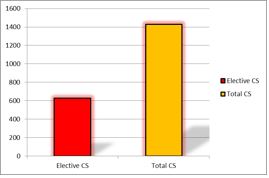“Rate and Indication of Elective Caesarean Section: A Retrospective Study”
Abstract
Background: The elective caesarean rate also contributes to increased total caesarean section ratesin recent times. This study was undertaken to know the elective caesarean section rate in a districthospital and the indications contributing to it.
Method: Sociodemographic data for the electivecaesarean section deliveries and indications of elective caesarean sections performed during oneyear from January 2020 to December 2020 at The Apollo Medical College and Government districthospital, Chittoor were collected in a retrospective manner.
Results: Elective caesarean section ratewas 43.85%. Booked multigravida women, 20 to 30 years old, studied up to metric, residing in arural area, belong to middle socioeconomic status were the majority to undergo elective C.S. RepeatC.S. made the most significant contribution to the elective C.S. rate followed by Cephalo-pelvicDisproportion.
Conclusions: Repeat C.S. and Cephalopelvic disproportion (CPD) are the mostcommon indications of elective caesarean section
Downloads
References
2. Kačerauskienė J, Barčaitė E, Bartusevičius A, Railaitė D, Nadišauskienė R. Maternal request is not to blame for an increase in the rate of Cesarean section. Medicina (Kaunas).2012;48(12):647-52.
3. De Padua KS, OSIS MJD, Faunder A, Barbosa AH, Filho OBM. Factors Associated with Caesarean Section in Brazilian Hospitals. Rev Saude Publica.2010;44(1)12-7.
4. Gayathry D, Guthi VR, Bele S, Vivekannada A. A study of maternal morbidity associated with caesarean delivery in tertiary care hospital. Int J Community Med Public Health.2017;4:1542-7.
5. Meikle SF, Steiner CA, Zhang J, et al. A national estimate of the elective primary cesarean delivery rate. Obstet Gynecol.2005;105:751-6.
6. Thakur V, Chiheriya H , Thakur A, Mourya S. Study of maternal and fetal outcome in elective and emergency caesarean section. Int J Med Res Rev.2015;3(11):1300-1305.
7. Benzouina S, Boubkraoui Mel-M, Mrabet M, Chahid N, Kharbach A, El-Hassani A, Barkat A. Fetal outcome in emergency versus elective cesarean sections at Souissi Maternity Hospital, Rabat, Morocco. Pan Afr Med J. 2016;23:197.
8. Darnal N, Dangal G, Maternal And Fetal Outcome In Emergency Versus Elective Caesarean Section. J Nepal Health Res Counc.2020;18(2):186-189.
9. Jain SM, Thool K, Shivkumar PV, Jain MA. Study of sociodemographic factors of women undergoing caesarean section in tertiary care centre of rural area of central India. Int J Reprod Contracept Obstet Gynecol.2019;8:4757-61.
10. Reddy KM, Sailaja LP, Kodimala SC, Pathakamudi P, Betha K. Prevalence and determinants of caesarean section in a rural tertiary teaching hospital: a 6-year retrospective study. Int J Reprod Contracept Obstet Gynecol.2019;8:560-5.
11. Radha, K., Prameela Devi, G. and Manjula, R.V. Study on rising trends of caesarean section (c-section): a bio-sociological effect. IOSR Journal of Dental and Medical Sciences (IOSR-JDMS).2015;14(8):10-13.
12. Diema Konlan K, Baku EK, Japiong M, Dodam Konlan K, Amoah RM. Reasons for Women's Choice of Elective Caesarian Section in Duayaw Nkwanta Hospital. J Pregnancy.2019;1-7.
13. Kathuria B, Sherin Raj TP. Regional Disparities and Determinants of Caesarean Deliveries in India. Ind J Youth Adol Health.2020;7(4):15-23.
14. Singh N, Pradeep Y, Jauhari S. Indications and Determinants of Cesarean Section: A Cross-Sectional Study. Int J Appl Basic Med Res.2020;10(4):280-285.
15. Herstad L, Klungsoyr K, Skjaerven R, Tanbo T, Eidem I, Forsen L, et al. Maternal age and elective cesarean section in a low-risk population. Acta Obstet Gynecol Scand.2012;91:816–23.
16. Wiklund I, Edman G, Larsson C, Andolf E. Personality and mode of delivery. Acta obstetricia et gynecologica Scandinavica.2006;85(10):1225-30.
17. Nourizadeh R, Mohamadpoor A, Kazempoor RM, Aghdam FB. Assessing birth method selection and related factors in women in Marand, Iran. Urumieh Journal of Nursing and Midwifery.2010;7(1):50-7.
18. Gurunule AA, Warke HS. Maternal and foetal outcome in elective versus emergency caesarean sections. Int J Reprod Contracept Obstet Gynecol.2017;6:1222-8.
19. Suja D, Manjusha V, Simi BN, Nazeema A. Study of maternal outcome of emergency and elective caesarean section in a semi-rural tertiary hospital. National J Med Res.2014;4(1):14-8.
20. Mandatory Second Opinion to reduce Unnecessary C- Sections: WHO 2018 Guidelines. Available at https://speciality.medicaldialogues.in/have-mandatory-second-opinion-to-reduce-unnecessary-c-sections-who-2018-guidelines/.
21. Govind L, Rajesh TV. Obstetric outcome in elective vs emergency caesarean section. Indian Journal of Research.2018;7(3):5-6.
22. Begum T, Rahman A, Nababan H, Hoque DM, Khan AF, Ali T, et al. Indications and determinants of caesarean section delivery: Evidence from a population-based study in Matlab, Bangladesh. PloS one.2017;12(11):1-16.
23. Ahmad H, Munim S. Isolated oligohydramnios is not an indicator for adverse perinatal outcome. Journal of the Pakistan Medical Association. 2009;59(10):691-94.
24. Quiroz LH, Chang H, Blomquist JL, Okoh YK, Handa VL. Scheduled cesarean delivery: maternal and neonatal risks in primiparous women in a community hospital setting. Am J Perinatol.2009;26(4):271-277.
25. Pallasmaa N, Ekblad U, Aitokallio-Tallberg A, Uotila J, Raudaskoski T, Ulander VM, Hurme S. Acta Obstet Gynecol Scand.2010;89(7):896-902.
26. Garima Nag G, Padmalatha VV, Rao SR. Maternal and Fetal Outcomes in Emergency versus Elective Cesarean Sections at a Tertiary Healthcare Setting in Southern India: A Prospective Observational Study. Journal of South Asian Federation of Obstetrics and Gynaecology, October-December 2018;10(2):413-418.
27. Pirjani R, Afrakhteh M, Sepidarkish M, Nariman S, Shirazi M, Moini A, Hosseini L. 'Elective caesarean section at 38-39 weeks gestation compared to > 39 weeks on neonatal outcomes: a prospective cohort study. BMC Pregnancy Childbirth.2018;18(1):140.
28. Mylonas I, Friese K: The indications for and risks of elective cesarean section. Dtsch Arztebl Int.2015;112:489–95.

Copyright (c) 2022 Author (s). Published by Siddharth Health Research and Social Welfare Society

This work is licensed under a Creative Commons Attribution 4.0 International License.


 OAI - Open Archives Initiative
OAI - Open Archives Initiative



















 Therapoid
Therapoid

